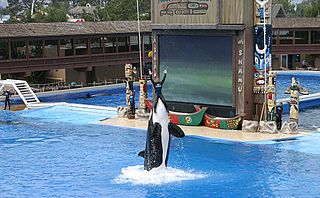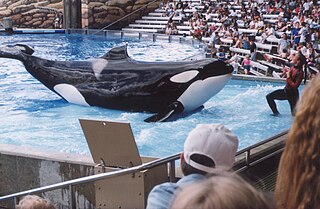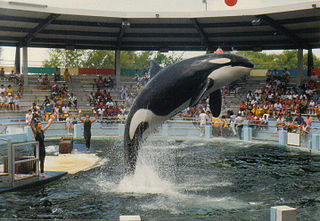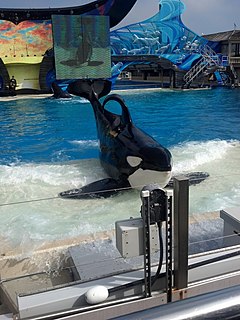 W
WCorky (II) is a female captive orca from the A5 Pod in British Columbia, Canada. She lives at SeaWorld San Diego in California. Corky (II) received her name after the park's original Corky died in December 1970. She has been in captivity longer than any other killer whale.
 W
WGranny, also known as J2, was an orca. She was estimated by some whale researchers to have been 105 years old, but her age is a source of dispute, with other studies putting her at age 65-80. If she was 105, she would have been the oldest known orca at the time of her death. A member of the endangered southern resident killer whale population, Granny lived in the northeast Pacific Ocean and coastal bays of Washington state and British Columbia. Granny was estimated to have been born in 1911. She was last seen on October 12, 2016, and was considered deceased by The Center for Whale Research in January 2017.
 W
WThis article gives a list of captive killer whales, or orcas, large predatory cetaceans that were first captured live and displayed in exhibitions in the 1960s, or were subsequently born in zoological facilities. They soon became popular attractions at public aquariums and aquatic theme parks due to their intelligence, trainability, striking appearance, playfulness in captivity and sheer size. As of February 2019, captive orcas reside at facilities in North and South America, Europe and Asia.
 W
WThis article gives a list of captive killer whales, or orcas, large predatory cetaceans that were first captured live and displayed in exhibitions in the 1960s, or were subsequently born in zoological facilities. They soon became popular attractions at public aquariums and aquatic theme parks due to their intelligence, trainability, striking appearance, playfulness in captivity and sheer size. As of February 2019, captive orcas reside at facilities in North and South America, Europe and Asia.
 W
WThis article gives a list of captive killer whales, or orcas, large predatory cetaceans that were first captured live and displayed in exhibitions in the 1960s, or were subsequently born in zoological facilities. They soon became popular attractions at public aquariums and aquatic theme parks due to their intelligence, trainability, striking appearance, playfulness in captivity and sheer size. As of February 2019, captive orcas reside at facilities in North and South America, Europe and Asia.
 W
WKasatka was a wild caught female orca who lived at SeaWorld San Diego.
 W
WKatina is a female orca who lives in SeaWorld Orlando in Florida. She was captured off Iceland at approximately three years of age on October 26, 1978. She is the most successful breeding female orca in captivity.
 W
WThis article gives a list of captive killer whales, or orcas, large predatory cetaceans that were first captured live and displayed in exhibitions in the 1960s, or were subsequently born in zoological facilities. They soon became popular attractions at public aquariums and aquatic theme parks due to their intelligence, trainability, striking appearance, playfulness in captivity and sheer size. As of February 2019, captive orcas reside at facilities in North and South America, Europe and Asia.
 W
WKeiko was a male orca who portrayed Willy in the 1993 film Free Willy. He was eventually freed in Iceland in July 2002, but died in December 2003 in Norway of pneumonia.
 W
WThis article gives a list of captive killer whales, or orcas, large predatory cetaceans that were first captured live and displayed in exhibitions in the 1960s, or were subsequently born in zoological facilities. They soon became popular attractions at public aquariums and aquatic theme parks due to their intelligence, trainability, striking appearance, playfulness in captivity and sheer size. As of February 2019, captive orcas reside at facilities in North and South America, Europe and Asia.
 W
WThis article gives a list of captive killer whales, or orcas, large predatory cetaceans that were first captured live and displayed in exhibitions in the 1960s, or were subsequently born in zoological facilities. They soon became popular attractions at public aquariums and aquatic theme parks due to their intelligence, trainability, striking appearance, playfulness in captivity and sheer size. As of February 2019, captive orcas reside at facilities in North and South America, Europe and Asia.
 W
WThis article gives a list of captive killer whales, or orcas, large predatory cetaceans that were first captured live and displayed in exhibitions in the 1960s, or were subsequently born in zoological facilities. They soon became popular attractions at public aquariums and aquatic theme parks due to their intelligence, trainability, striking appearance, playfulness in captivity and sheer size. As of February 2019, captive orcas reside at facilities in North and South America, Europe and Asia.
 W
WLolita is a 20-foot-long (6 m), 7,000 pounds (3,200 kg) orca who has lived at the Miami Seaquarium since 1970.
 W
WLuna also known as L98 or Tsux'iit, was a killer whale (orca) born in Puget Sound. After being separated from his mother while still young, Luna spent five years in Nootka Sound, an ocean inlet of western Vancouver Island, where he had extensive human contact and became recognized internationally.
 W
WThis article gives a list of captive killer whales, or orcas, large predatory cetaceans that were first captured live and displayed in exhibitions in the 1960s, or were subsequently born in zoological facilities. They soon became popular attractions at public aquariums and aquatic theme parks due to their intelligence, trainability, striking appearance, playfulness in captivity and sheer size. As of February 2019, captive orcas reside at facilities in North and South America, Europe and Asia.
 W
WMorgan is a female orca who was rescued in the Wadden Sea, off the northwestern coast of the Netherlands in June 2010. She was found in an unhealthy condition, severely underweight and malnourished. She lived several months at the Dolfinarium Harderwijk in the Netherlands. After it became clear that the basin at Dolfinarium was too small, multiple options were considered, including releasing Morgan and transferring her to another facility. Over a year later, after litigation and debate between scientists, a Dutch court ruled that she was to be moved. Morgan was transported to the Loro Parque in Spain in November 2011.
 W
WOld Tom was a killer whale (orca) known to whalers in the port of Eden, New South Wales, on the southeast coast of Australia. Old Tom measured 22 feet (6.7 m) and weighed 6 tons, with a 3.33 feet (1 m) skull and teeth about 5.31 inches (13.4 cm) long.
 W
WScarlet, also named J50, was a juvenile female member of the endangered Southern Resident Orca group in Puget Sound, Washington. She was born near South Pender Island, British Columbia around Christmas Day, 2014. In late June, 2018, Scarlet appeared emaciated and was feared near death. Another calf died in late July, 2018 leaving Scarlet "represent[ing] the future" of the declining Southern Residents, thought to number 75, cut off from their food supply of Puget Sound chinook salmon, themselves listed as a threatened species. Scarlet's mother, known as J16, was born in 1972.
 W
WSpringer, officially named A73, is a wild orca from the Northern Resident Community of orcas which every summer frequent the waters off the northern part of Vancouver Island, British Columbia (BC). In January 2002, Springer, then a calf developmentally equivalent to a human toddler, was discovered alone and emaciated some 250 miles from the territory of her family. Experts identified Springer by her vocal calls that are specific to her family, or "pod," and by examining photographs of her eye patch. They were also able determine where Springer's pod was currently located.
 W
WThis article gives a list of captive killer whales, or orcas, large predatory cetaceans that were first captured live and displayed in exhibitions in the 1960s, or were subsequently born in zoological facilities. They soon became popular attractions at public aquariums and aquatic theme parks due to their intelligence, trainability, striking appearance, playfulness in captivity and sheer size. As of February 2019, captive orcas reside at facilities in North and South America, Europe and Asia.
 W
WTilikum, nicknamed Tilly, was a captive orca, who spent most of his life performing at SeaWorld Orlando. He was captured in Iceland in 1983 at Hafnarfjörður, near Reykjavík. About a year later, he was transferred to Sealand of the Pacific in Victoria, British Columbia. He was subsequently transferred in 1992 to SeaWorld Orlando, Florida. He sired 21 calves, of which ten are still alive.
 W
WUlisses is a male orca who currently lives at SeaWorld San Diego in California. He was captured on November 7, 1980 at Reydarfjördur, Iceland, when he was approximately 3 years old. He lived at several parks including the Sædyrasafnid Aquarium in Iceland, and the Rioleón Safari, and Barcelona Zoo in Spain, before being transported to SeaWorld in 1994.
 W
WThis article gives a list of captive killer whales, or orcas, large predatory cetaceans that were first captured live and displayed in exhibitions in the 1960s, or were subsequently born in zoological facilities. They soon became popular attractions at public aquariums and aquatic theme parks due to their intelligence, trainability, striking appearance, playfulness in captivity and sheer size. As of February 2019, captive orcas reside at facilities in North and South America, Europe and Asia.